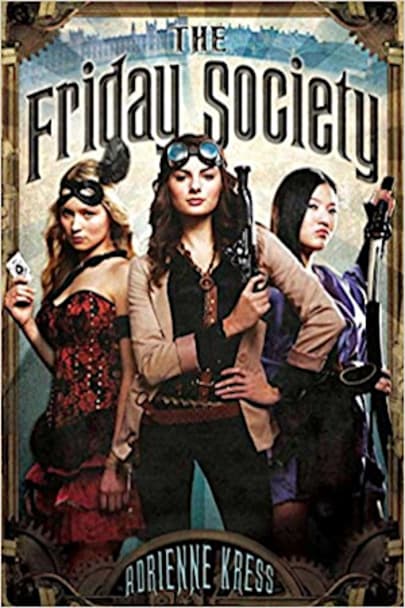An action-packed tale of gowns, guys, guns–and the heroines who use them all
Set in turn of the century London, The Friday Society follows the stories of three very intelligent and talented young women, all of whom are assistants to powerful men: Cora, lab assistant; Michiko, Japanese fight assistant; and Nellie, magician’s assistant. The three young women’s lives become inexorably intertwined … inexorably intertwined after a chance meeting at a ball that ends with the discovery of a murdered mystery man.
It’s up to these three, in their own charming but bold way, to solve the murder–and the crimes they believe may be connected to it–without calling too much attention to themselves.
Set in the past but with a modern irreverent flare, this Steampunk whodunit introduces three unforgettable and very ladylike–well, relatively ladylike–heroines poised for more dangerous adventures.
more



Caution: Contains one spoiler.
Anyone who has ever spoken to me at length about steampunk will know this: While I do love steampunk, I’m a bigger fan of the idea of steampunk than I am of most steampunk books. My main complaint against them is that they tend to treat the pseudo-Victorian aesthetic as a decoration, rather than an integral part of the world of the story. Occasionally, though, I happen upon a steampunk novel that takes that decoration and rocks it.
The Friday Society by Adrienne Kress rocks hard in all the ways that steampunk should.
In the novel, Cora is assistant to a mad scientist, with all the science brains and cool tech knowledge implied; Nellie is assistant to a magician, armed with sparkly dresses, sneak tactics galore, and a parrot sidekick; and Michiko is a Japanese assistant to an English fight instructor, who knows more about katana combat than her present charlatanic master. When heads start rolling in the London streets—the first right at their feet, in fact—they take it upon themselves to solve the mystery with sassy, street-smart girl power and more than a little technological mayhem.
These are combinations that could not exist outside a steampunk novel and still make sense.
At its heart, The Friday Society reads like Kress said, “OK—I’m going to take everything that is awesome about steampunk, trash the rest, put it in a blender with some glitter and Japanese swordplay and see what happens.” Which is why there is almost no affected fake-Victorian language in this thing, and why the novel foregoes the tedious details of Victorian manners and society to toss an explosion at readers in the first sentence. There are also magical gravity-defying minerals and a super fancy gun that can be worn like armor until an electromagnetic pulse calls its pieces into weapon form.
The protagonists, too, are sneakily developed, looking like stereotypes on the surface—the tomboy, the girly girl, the samurai—but revealing some clever variations on their types as the novel progresses. Michiko, for example, is the stoic, silent, samurai sort one would expect—but only because she doesn’t know enough English to use the language and so stays quiet to avoid making herself look foolish. Cora and Nellie take it upon themselves to teach her the language, and ultimately, it is these three characters and their interactions that make the novel worth the read. Stylistically, it aspires to read like a steampunk cousin of sassy fantasies like The Princess Bride or Stardust, a feat largely accomplished through the girls’ banter. Though they never actually reach Princess Bride levels of wit—though, really, what other than The Princess Bride itself can do that?— its sense of humor was close enough and uncommon enough in steampunk novels that it kept me reading.
However, even though the strengths outweighed them for me, the book does have some weaknesses worth mentioning. There’s an attempted romantic storyline that falls absolutely flat—but this is a book about girls kicking butt, so that’s ok. The story also involves a secondary murder mystery that I found completely throwaway once it was solved, and once readers find out the eventual bad guy’s motivation, it is frustratingly feminist (that is, feminist in a negative way). BTW THIS IS THE SPOILER PART. WATCH OUT. This seems odd to say about a book that is unabashedly about girl power, but when the antagonist’s reason for murdering everyone (and then some) comes down to “THE MEN DIDN’T THINK MY IDEAS WERE GOOD BECAUSE I WAS A GIRL SO I’LL SHOW THEM >( ” it’s a bit anticlimactic, and not entirely believable. (A younger me was a tomboyish girl who wanted to excel at boy things like science and blowing things up, but I was never motivated to do such things because people told me I was too girly to succeed at them. I simply wanted to do them because I wanted to do them.) Finally, the novel makes a noble stab at having a diverse cast—Michiko is trained by a local Japanese expatriate, and Nellie works for an exotic Oriental magician—but most of the multicultural characters in the novel ultimately fall into convenient stereotype. Nellie’s magician, though interesting, exists only to be exotic and mysterious, and Michiko’s mentor reads like he popped out of The Karate Kid.
Taken as a whole, though, The Friday Society ranks among my favorite fun steampunk novels. It’s not flawless, but it’s still the most entertaining piece of steampunk quirk that I’ve read since Phil and Kaja Foglio’s classic Girl Genius.